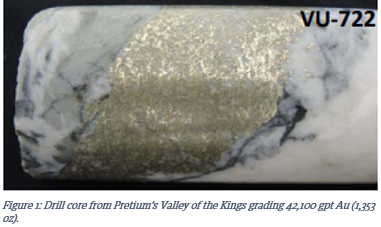Gold Deposits and Characteristics
As a follow-up to our Outlook on how ore deposits are formed, we thought it practical to dive a bit deeper and discuss how specific deposits are formed, beginning with gold. While our investment criteria are multi-faceted, we will focus this discussion on the geological characteristics we use to assess investment opportunities in the mining sector. The gold sector has attracted a great deal of investment over the last year as gold prices climbed to all-time highs back in early August peaking at US$2,063/oz. This caused a frenzy in the mining sector with exploration companies vying for capital for various different types gold deposits. The more common types of deposits that we typically assess are classified as epithermal, carlin-type, and orogenic gold.
Epithermal gold deposits are typically what you may picture of when thinking of gold deposits. Gold occurs in quartz veins and is typically quite shallow with bonanza grades. Japan’s Hishikari is one of the world’s highest-grade gold mines with an average of 30-40 gpt Au. A key exploration criterion for these types of deposits is knowing where you are vertically in these systems. As a Geologist, we would look for certain textures, such as bladed calcite in the veins which is a key indication for boiling fluids and gold deposition. That being said, many other factors come in to play and from discovery to production can take decades. Pretivm’s Brucejack mine here in BC, was first identified in the 1960’s and it wasn’t until 2009 when Silver Standard drilled 16,948 gpt Au (545 oz), that the true potential was unlocked.

Carlin-type deposits are generally only found in Nevada and known to be some of the most prolific gold deposits. Gold production from Nevada accounts for 78% of US gold and 5% of the world’s production. Total gold production since 1835 from Nevada tops 206M ounces and worth an estimated US$320B dollars at today’s gold prices. These deposits are very complex and a strong understanding of stratigraphy (sequence of sedimentary rocks) can lead explorers to the right host rocks. Gold is typically very fine grained, disseminated and oxidized. Oxidization is very important because it allows for these low-grade deposits to be mined inexpensively through leaching techniques without the need for more expensive production methods such as autoclaves.
Orogenic gold (or Greenstone hosted) is the favourable deposit model type we see in Eastern Canada (Ontario and Quebec) accounting for ~75% of the gold mined in Canada. These deposits are hosted in some of the oldest rocks (2.7B years old) in the world and related to deep seated faults that rapidly bring fluids towards the surface. Unlike epithermal deposits, the fluids are under higher confining pressures and don’t boil, thus we see gold deposition over a greater vertical depth. Structure is critical in the formation and exploration of these deposits and a strong understanding of these pathways can lead to major discoveries.
“This means that” good geology, patience and a little bit of luck are key to success in gold mining and through a deeper understanding of different ore deposits we can make informed investment decisions on the merit of these assets.
National Instrument 31-103 requires registered firms to disclose information that a reasonable investor would expect to know, including any material conflicts with the firm or its representatives. Doug Johnson and/or Pathfinder Asset Management Limited are an insider of companies periodically mentioned in this report. Please visit www.paml.ca for full disclosures.
*All returns are time weighted and net of investment management fees. Returns from the Pathfinder Partners’ Fund and Partners’ Real Return Plus Fund are presented based on the masters series of each fund. The Pathfinder Core: Equity Portfolio and The Pathfinder Core: High Income Portfolio are live accounts. These are actual accounts owned by the Pathfinder Chairman (Equity) and client (High Income) which contain no legacy positions, cash flows or other Pathfinder investment mandates or products. Monthly inception dates for each fund and portfolio are as follows: Pathfinder North American: Equity Portfolio (January 2011), Pathfinder North American: High Income Portfolio (October 2012) Pathfinder Partners’ Fund (April 2011), Pathfinder Real Return Plus Fund (April, 2013), Pathfinder International Fund (November 2014) and Pathfinder Resource Fund (May 2018).
Pathfinder Asset Management Limited (PAML) and its affiliates may collectively beneficially own in excess of 10% of one or more classes of the issued and outstanding equity securities mentioned in this newsletter. This publication is intended only to convey information. It is not to be construed as an investment guide or as an offer or solicitation of an offer to buy or sell any of the securities mentioned in it. The author has taken all usual and reasonable precautions to determine that the information contained in this publication has been obtained from sources believed to be reliable and that the procedures used to summarize and analyze such information are based on approved practices and principles in the investment industry. However, the market forces underlying investment value are subject to sudden and dramatic changes and data availability varies from one moment to the next. Consequently, neither the author nor PAML can make any warranty as to the accuracy or completeness of information, analysis or views contained in this publication or their usefulness or suitability in any particular circumstance. You should not undertake any investment or portfolio assessment or other transaction on the basis of this publication, but should first consult your portfolio manager, who can assess all relevant particulars of any proposed investment or transaction. PAML and the author accept no liability of any kind whatsoever or any damages or losses incurred by you as a result of reliance upon or use of this publication.